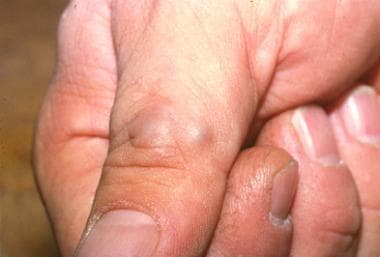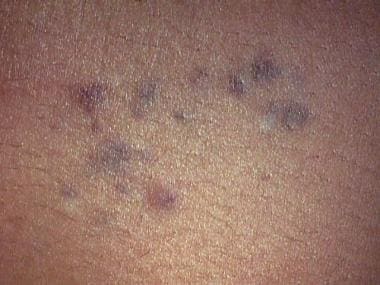Background
Glomus tumors are rare soft-tissue neoplasms of the neuromyoarterial glomus body that account for approximately 2% of all soft-tissue tumors in the extremities. [1, 2] They typically present in adults (ages 20-40 y) as small, blue-red papules or nodules of the distal extremities, with most cases involving subungual sites. These tumors are characteristically painful, often causing paroxysmal pain in response to temperature changes (especially cold) or pressure.
Note the images below.
Glomus tumors are thought to arise from the glomus body or Sucquet-Hoyer canal, a thermoregulatory arteriovenous shunt composed of modified smooth muscle cells. [3, 4] Glomus tumors most frequently occur in areas with high concentrations of glomus bodies, including subungual regions of the fingers and the deep dermis of the hand (palm), forearm, and foot (sole). The subcutaneous nodules may be red, purple, or blue depending on their depth. Most lesions are solitary and localized to cutaneous sites.
Glomuvenous malformations (GVMs), formerly known as glomangiomas, have also been described. While once considered a subset of glomus tumors, GVMs are now widely considered to be unrelated in pathogenesis given their differences in clinical and histopathologic features. While the vast majority of glomus tumors are benign, malignant cases have been rarely reported, with such cases typically being locally invasive. Malignant glomus tumors are more likely to be deep, larger than 2 cm, and have atypical features. [5] Metastases are exceedingly rare. [5, 6, 7, 8, 9]
Pathophysiology
Glomus bodies play an important role in thermoregulation via arteriovenous shunting. The glomus body is composed of an afferent arteriole, anastomotic vessel (termed Sucquet-Hoyer canal), primary collecting vein, intraglomerular reticulum, and a capsular portion. These specialized arteriovenous anastomoses are particularly concentrated in the reticular dermis of the fingers.
Glomus tumors are thought to represent hamartomatous proliferations of modified smooth muscle cells originating from preexisting normal glomus cell populations. The three components of most glomus tumors include glomus cells, vasculature, and smooth muscle cells. The most common type of glomus tumor is the solid glomus tumor, characterized by a prominent smooth muscle cell component. [10]
While glomus tumors predominate on the hands and fingers, these tumors can occur in a wide anatomic distribution, including sites not known to contain glomus cells, such as deep soft tissues, nerve, bone, and abdominal viscera. In fact, gastric glomus tumors account for approximately 2% of benign gastric tumors. [11] These tumors may arise from perivascular cells or pluripotent mesenchymal cells capable of differentiating into glomus cells.
Most glomus tumors are solitary and sporadic. An epidemiologic relationship may exist between glomus tumors and neurofibromatosis, which most often produces subungual glomus tumors. [12, 13, 14] A distinct but related condition known as glomuvenous malformations (GVMs) differ clinically from glomus tumors in that they occur more often in children and adolescents, are typically multifocal, and do not have a predilection for subungual sites. GVMs are more likely to be hereditary and painless.
It is thought that GVMs and glomus tumors have different etiologies, with GVMs resembling venous malformations and containing more dilated venous channels than glomus tumors.
Note that most cases of GVM are sporadic; however, familial cases with autosomal dominant inheritance patterns have also been described. Such familial GVMs have been mapped to 1p21-22 and are thought to result from loss-of-function mutations in the cytoplasmic protein glomulin. [15, 16, 17, 18]
Rarely, glomus tumors can undergo malignant transformation or malignant glomus tumors can arise de novo. Malignant glomus tumors are termed glomangiosarcomas; glomangiosarcomas have a high local recurrence rate but very low rate of metastasis. [5, 6, 7, 19, 20, 21, 22, 23, 24] One case report describes a glomangiosarcoma that occurred at a prior biopsy site of a lower extremity, perhaps due to local recurrence of glomangiosarcoma and/or malignant transformation. [25] In one rare case of malignant glomus tumor involving the brachial plexus, excision was foregone owing to potential morbidity, and the glomus tumor was found to be sensitive to chemotherapy against the oncogenic BRAF, with resultant moderate reduction in tumor size. [22] In fact, other glomus tumors have also been found to have BRAF mutations, suggesting this may be a marker of malignant potential and/or a therapeutic target, although further study is needed. [26]
Etiology
Glomus tumors are neoplasms caused by a proliferation of glomus cells, which make up a portion of the glomus body. The initiating event for glomus cell proliferation is unknown. Some authors have postulated that trauma induces solitary subungual glomus tumors, although this theory is not well studied.
Most glomuvenous malformations (GVMs) are inherited in an autosomal dominant pattern with incomplete penetrance. Most hereditary GVMs are associated with defects in the glomulin gene (GLMN) located on chromosome 1. [15, 16, 17]
Epidemiology
Frequency
Glomus tumors account for 1-5% of all soft-tissue tumors of the upper extremity, occurring in most cases in the nail bed [27] ; however, the true incidence of glomus tumors could be even higher, likely as a result of misdiagnosis of many of these lesions as hemangiomas or venous malformations.
Glomuvenous malformations (GVMs) are much less common than glomus tumors. [17] Such cases are seen more frequently in children, with the majority of patients reporting a positive family history.
An epidemiologic relationship may exist between glomus tumors and neurofibromatosis, which most often produces subungual glomus tumors. [12, 13, 14]
Sex
Glomus tumors in general show no sex predilection; however, solitary subungual lesions are more commonly observed in women and multiple lesions are slightly more common in men. [4, 28, 29]
Age
Solitary glomus tumors can occur at any age. While previously thought to occur predominantly in young adults (ages 20-40 y), they have also been reported to be frequent in older adults (ages 40-70 y). [3] GVMs are often multifocal and typically are present at birth or early in life.
Prognosis
The prognosis for patients with glomus tumors is excellent. Excision of painful lesions most often results in cure, with a low recurrence rate for solitary lesions. [30, 31] With subungual glomus tumors, the most important complications are recurrence and nail deformity; recurrence requires repeat wide excision. [4] Additionally, one case report describes infection due to rupture of a subungual glomus tumor. [32]
Malignant glomus tumors are usually locally infiltrative/aggressive. Their overall prognosis is good if they are treated with wide excision; otherwise, there is a risk of local recurrence. For example, a 2017 study of malignant glomus tumors of the head and neck reports recurrence in 45% of patients. [20] While extremely rare, metastases have been described and are associated with a poor prognosis. [5, 6, 7, 19]
Patients with glomus tumors classically present with paroxysmal severe pain, often precipitated by cold, pressure, or dependency. Pain is more common in solitary lesions. The multiple tumors of glomuvenous malformations (GVMs) arise in younger patients and tend to be asymptomatic.
Systemic effects of glomus tumors are rare; however, in one report, a patient with more than 400 glomus tumors developed thrombocytopenia as a result of platelet sequestration. [33]
-
Glomus tumor.
-
Multiple glomus tumors.
-
Glomus tumor (4X). The tumor is composed of uniformly round, small, glomus cells with pale eosinophilic cytoplasm associated with conspicuous vasculature.
-
Glomus tumor (10X).
-
Glomangioma (2X). In this variant, blood vessels predominate.
-
Glomangioma (10X). Note the typical small, round glomus cells, often distributed in a monolayer or bilayer within the vessel walls.










